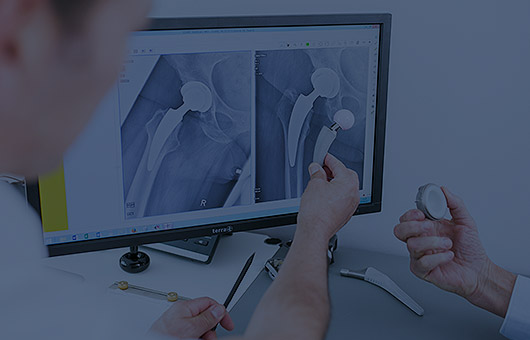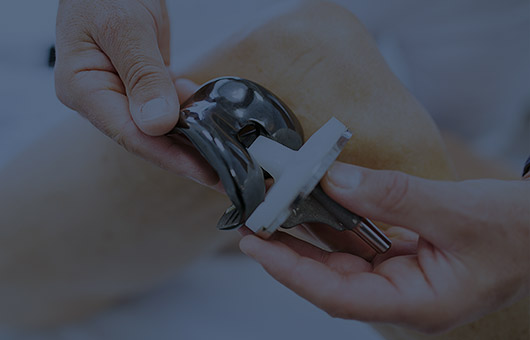The prosthesis operation: Answers to important questions
Video: “Hip prosthesis, knee prosthesis -- what happens during surgery?” (german language)
Important facts about the operation
A well-informed patient will get through the first few weeks more easily. I am happy to explain important questions about a prosthetic operation. For example, you will learn about dangerous hospital germs. I will also tell you what happens on the day of the surgery and how the first days and weeks usually work out.
What do I need to prepare for an operation?
After we have decided on a surgery date, you will receive a consultation appointment with the anaesthesiologist. He will explain the type of anaesthesia you require (general anaesthesia or spinal anaesthesia) as well as possible benefits or risks. You will be asked about your pre-existing conditions and examined in order to be able to assess the risk of anesthesia correctly. Accordingly, please bring along documents, current medical reports or laboratory findings to the consultation. Underlying values and examinations, which are needed before any surgery under anesthesia, are:
- small blood count (hemoglobin, platelets, leukocytes)
- blood coagulation (Quick value or INR, PTT)
- electrolytes (potassium, sodium, calcium)
- kidney function values (creatinine, possibly also creatinine clearance)
- liver enzymes (AST, APT, gamma-GT)
- current ECG (if you are older than 60 years or have a pre-existing heart condition)
What happens when testing for resistant germs (MRSA screening)?
We want to rule out, with the highest possible degree of certainty, the possibility that you as an inpatient in the Lilium clinic are an unknown carrier of methicillin-resistant bacteria. This is for your own protection as well as the protection of other surgical patients. The most likely locations of MRSA are the nose and throat. Therefore, swabs from the nasal vestibule and pharynx are obtained in all patients about two weeks before the scheduled hospitalization. This usually happens at the same time as the appointment for anesthesia.
In most cases the swab will be negative (no MRSA available), then the next steps will take place as planned. If, however, the swab proves to be a (previously unrecognized) MRSA infestation, you must first be disinfected before hospitalization. This is done at home and includes disinfecting nose ointments, gargling with a mucosal antiseptic, whole body washes with antiseptic wash solutions and a daily change of bed and body linens, towels and wash cloths.
Will I be sufficiently treated for pain?
Immediately after surgery, you will receive both anti-inflammatory drugs (such as Celebrex or ibuprofen) as well as potent analgesics (such as opioid modifications). These medicines are given to you periodically to maintain a sufficient blood level. The nursing staff and the medical service repeatedly ask you about your own personal sense of pain so that you can be given additional infusions, injections or oral medications if necessary.
Often the pain after hip replacement is described as being quite low or tolerable, so that the pain medications can be reduced after one to two days. The pain after (complete) knee replacement can be a bit stronger and last longer. Here we customize your medication individually, so that it can be easily made available to you. The so-called “pain catheters” sometimes have the disadvantage of paralyzing the leg muscles (danger of falling) and delaying their mobilization. Therefore, pain catheters are not used in the Lilium clinic.
How does the protection against a leg vein thrombosis occur?
Thrombosis protection measures are based on three pillars:
- compression of the leg by anti-thrombosis stockings or winding
- rapid activation of the muscle pump of the calves and mobilization
- medical thrombosis protection
It is important to weigh the advantage of medical thrombosis protection against the disadvantages of greater hematoma formation or secondary bleeding. A proven medical thrombosis protection is the injection of (low molecular weight) heparins under the skin. In recent years, tablets have proven to be an alternative thrombosis protection. Because of the higher level of comfort and the same level of safety, you will receive a thrombosis protection tablet in the Lilium clinic at noon. According to current guidelines, the thrombosis protection measures must be strictly performed after a hip TEP for four weeks, and after a knee TEP for two weeks.
How will I be mobilized after the operation?
There are many well-designed mobilization schemes (fast track, rapid recovery, hip stop). However, they often have the disadvantage of pressing patients into a rigid after-treatment template and do not take personal histories into account. You will of course be quickly mobilized In the Lilium clinic, but we adapt your mobilization to your respective condition.
The Lilium clinic does not employ physiotherapists. As a patient, you will receive appropriate recipes from me with which you can commission a suitable physiotherapy practice. Most of my patients are treated by Dolfus & Labermeier physiotherapists, who are in the clinic building. These therapists work in close consultation with me. A 30-minute bodyweight session and a 45-minute lymphatic drainage per day (also on Saturdays!) have proven to be effective.
Do I need an inpatient or outpatient rehab programme?
This is a decision that must take into account both your individual home situation as well as the extent of your osteoarthritis and the nature of the surgery. Younger patients with a hip or a sled prosthesis may tend to be well mobilized on an outpatient basis. Older patients, especially those with a demanding home-based situation (such as many steps) and hard to reach physiotherapy, are certainly better off in a rehab clinic.
In any case, we will help you organize the after-care. In case of inpatient rehabilitation you will be registered by the Lilium clinic at the rehabilitation clinic. A request will then be made to the insured person. As a rule, we also manage a seamless transition directly from the hospital to the rehabilitation clinic. In the case of an outpatient rehabilitation, I will gladly look after you during my outpatient consultation.

